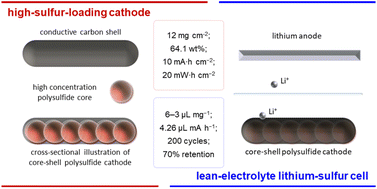Integrated high-sulfur-loading polysulfide/carbon cathode in lean-electrolyte cell toward high-energy-density lithium–sulfur cells with stable cyclability†
Abstract
The commercialization of high-energy-density lithium–sulfur batteries depends on the development of a high-sulfur-loading cathode with high electrochemical utilization and stability in lean-electrolyte cells. However, the desired cell-design parameters often exacerbate the sluggish conversion reaction between sulfur and sulfide and intensify polysulfide diffusion. This results in low specific capacity, considerable capacity degradation, and a short cycle life, thus worsening the electrochemical performance. Here, we present a new design of the cathode material and configuration: a core–shell polysulfide/carbon cathode. The cathode contains a high amount of high-activity polysulfide catholyte as its active core, and the catholyte is sealed in a conductive shell made of an entangled fabric-like, tubular carbon tissue with low nanoporosity. The material design allows for fast redox kinetics and charge transfer, and the designed cell configuration stabilizes the electrochemical reaction. Thus, the lean-electrolyte lithium–sulfur cell achieves a record low electrolyte-to-sulfur ratio (4–3 μL mg−1), while enabling the core–shell polysulfide/carbon cathode with a high sulfur loading and content (12 mg cm−2 and 64.1 wt%, respectively) to exhibit a high peak charge-storage capacity (832 mA h g−1 at a 0.10C rate), high rate performance (0.10C–0.20C), and long-term cyclability with high capacity retention approaching 70% after 200 cycles.



 Please wait while we load your content...
Please wait while we load your content...